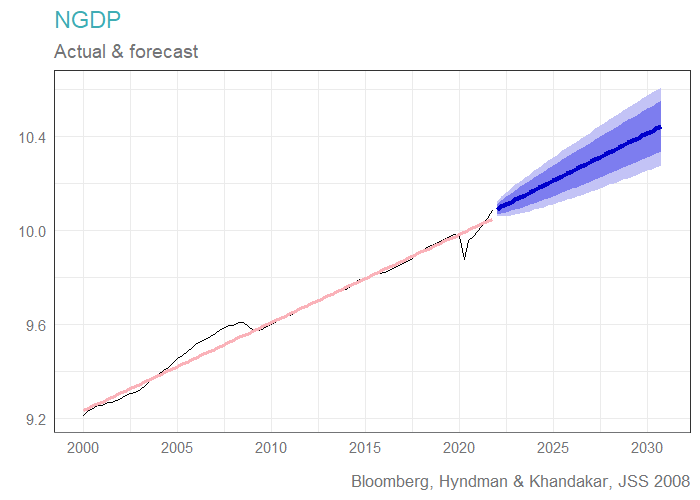The Fed remains well behind the curve
Why do we keep talking about the prospect of higher interest rates? What sort of analytical support can we offer to evidence such a proposition?
It's an important question to answer, given that higher rates, indeed materially higher rates, are a clear overhang from property to shares to subsets of shares (such as growth or value strategies) and everything in between, due to the common discount factor they share, in which the risk free rate features prominently.
Firstly, let us look the US GDP data release overnight. We see a full recovery from the pandemic, surpassing the prior peak, and edging comfortably above the pre-pandemic long run trend, which at a high level mimics the long run growth rate of potential output. That's great!

So what about monetary policy? Well, short term nominal cash rates continue to be anchored at zero, with lift-off likely in the near term, possibly as soon as March, in the case of the US Federal Reserve, albeit "lift-off" is generally viewed as a hike in the order of 25 basis points.
In other words, emergency policy settings are still in effect, despite nominal demand that has more than fully recovered. That strong growth rate will moderate, over time, but is nonetheless expected to remain elevated for some time. With that in mind, it is interesting to note the relationship between the 1yr ahead NGDP forecasts, from the Survey of Professional Forecasters, and the US 10 year treasury yield.

Whilst you can see a clear bend in the slope, by decade, the 2020’s era is very unusual. At the very least, the historical relationships, suggested by economic theory, support a markedly higher treasury yield story, than what prevails today, which is a 10 year yield below 2%.
It is the same when we look at the relationship between inflation and treasury yields. Whilst the curve has flattened over time, current inflation prints would ordinarily be associated with markedly higher treasury yields.

Durable goods, also out overnight, tells a similarly positive story. Ordinarily, one would have begun to normalise policy settings, given the kinds of cyclical strength we see below, and what the inflation data tells us about the aggregate supply curves.

So let us bring out the conclusion. The US Fed is behind the curve. There is an old saying in funds management "don't fight the Fed".
Here, the econometric evidence, whilst simplistically presented, makes for a compelling case that the Fed now needs to play catch up. Prior tightening cycles happened when inflation was much lower, and unemployment much higher, than it is today. That's where the rationale for "catch up" comes from.
Long duration assets are most at risk in such a tighter than expected scenario. That means infrastructure, listed and unlisted, which continue to trade at elevated multiples, and long duration secular growth stocks, where the earnings, many years from now, are discounted at higher rates, which lowers their net present value today.
We've seen but a taste of this, in our view, with the past months' volatility and underperformance in flagship strategies such as the ARKK Innovation fund, and growth stocks more generally.
2 topics

